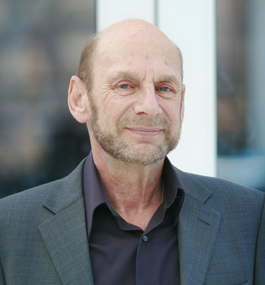Baltes Award Goes to Neuroscientist Art Wingfield

Mike Lovett
Art Wingfield
by Susan Chaityn Lebovits
Neuroscientist Arthur Wingfield says a 10-cent book on bioengineering from a discount shop jump-started his career. The leather-like cover with gold letters drew him in while the section on speech as an engineering problem proved inspiring.
A world leader in researching sensory and cognitive changes in aging, Wingfield, the Nancy Lurie Marks Professor of Neuroscience and the director of the Volen National Center for Complex Systems, most recently won the 2010 Baltes Distinguished Research Achievement Award. The accolade was given for his outstanding contributions to understanding adult development and aging, with a specific emphasis on how hearing loss affects memory.
It’s not surprising, he explains, that if someone has to struggle to hear through a bad cell phone connection or traffic noise, it takes a lot of effort. In an older adult, he says, the degree of effort and cognitive resources required can attenuate memory. In other words, efforts that would have been used for encoding memories are instead exhausted to understand sentences, many of which have complicated syntax or present other challenges to the older listener, such as difficult pitches or frequencies.
Wingfield says that the thinning of hair cells in the cochlea, a snail-shell shaped structure the size of a Tic-Tac in the inner ear, is usually the source of the hearing loss. While a number of creatures, like sharks, grow new hair cells, humans do not. The best that we can do, other than hearing aids, says Wingfield, is cochlear implants.
Currently Wingfield is collaborating on the use of functional magnetic resonance imaging to research brain activity as it processes rapid speech or complicated grammar. In the younger person, says Wingfield, activity occurs mainly in the left hemisphere, the area for language. If speech is significantly more complicated in the younger adult, activity is then picked up in the right hemisphere. In the older adult, however, Wingfield says this pattern appears earlier and with simpler language.
A world leader in researching sensory and cognitive changes in aging, Wingfield, the Nancy Lurie Marks Professor of Neuroscience and the director of the Volen National Center for Complex Systems, most recently won the 2010 Baltes Distinguished Research Achievement Award. The accolade was given for his outstanding contributions to understanding adult development and aging, with a specific emphasis on how hearing loss affects memory.
It’s not surprising, he explains, that if someone has to struggle to hear through a bad cell phone connection or traffic noise, it takes a lot of effort. In an older adult, he says, the degree of effort and cognitive resources required can attenuate memory. In other words, efforts that would have been used for encoding memories are instead exhausted to understand sentences, many of which have complicated syntax or present other challenges to the older listener, such as difficult pitches or frequencies.
Wingfield says that the thinning of hair cells in the cochlea, a snail-shell shaped structure the size of a Tic-Tac in the inner ear, is usually the source of the hearing loss. While a number of creatures, like sharks, grow new hair cells, humans do not. The best that we can do, other than hearing aids, says Wingfield, is cochlear implants.
Currently Wingfield is collaborating on the use of functional magnetic resonance imaging to research brain activity as it processes rapid speech or complicated grammar. In the younger person, says Wingfield, activity occurs mainly in the left hemisphere, the area for language. If speech is significantly more complicated in the younger adult, activity is then picked up in the right hemisphere. In the older adult, however, Wingfield says this pattern appears earlier and with simpler language.
